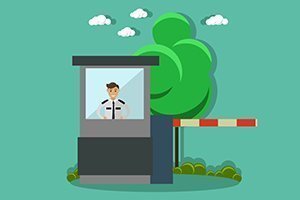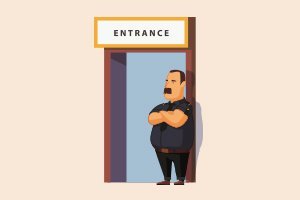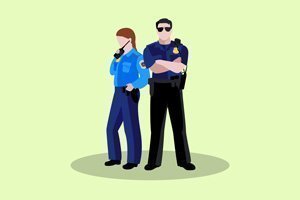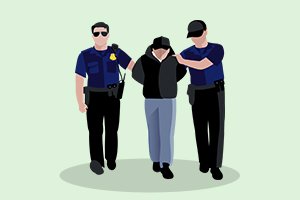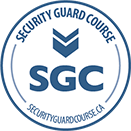Use of Force – How to recognize signs of Aggression and Potential Attack
There are circumstances under Section 25 of the Criminal Code (Canada)that provide protection for a Security Guard who uses force on the job, however; it also holds the guard accountable for his or her actions. This means if a guard uses excessive force, or uses force inappropriately, they can be charged under the criminal code. This is why it’s important to determine what constitutes reasonable force and what situations might warrant it. You can get this invaluable training by taking our online Use of Force course. There will be times on the job when the Use of Force may be necessary for self defense or to ward off an attack, but how do you know when you are being threatened?
One of the important topics covered in our course is how to recognize potential signs of attack on the job and how to tell if someone is aggressive. Read on to learn more.
How much force can a security guard use?
Section 25 of the Criminal Code (Canada) provides protection for persons who must use force to carry out their responsibilities such as those in the security industry. If you have to use force to make an arrest, remove a trespasser, conduct a search, or seize articles, you are within your rights as long as your actions are reasonable given the circumstances and the amount of force used is no more than is necessary to accomplish the job.
What are the early warning signs for violent attack? How do I know when someone is threatening?
While there are several factors security guards must take into consideration when accessing a situation for the use of force, a big part of that assessment is understanding and evaluating signs that someone may be threatening. A subject may exhibit behavior that can help determine whether or not they are about to attack. The following are identified by the Canadian Association of Chiefs of Police as signs of a potential attack:
-
- Ignoring the officer/guard
- Repetitious questioning
- Aggressive verbalization
- Emotional venting
- Refusing to comply with lawful request
- Ceasing all movement
- Invasion of personal space
- Adopting an aggressive stance
- Hiding
If a subject ignores your requests and is aggressive verbally, then it is a pretty good indication that the situation may become elevated and that use of force may be necessary. If a person stands still and adopts an aggressive stance it is another sign that they may be entering attack mode. In addition to assessing the individual who is a potential threat, the situation including environment and surroundings also need to be accessed. Factors that affect the situation are also covered in our Use of Force Training. All must be evaluated before using force.
Are there physical signs that someone may become violent?
In a word, yes. Body language can be an indicator of hostility. According to Science of People, some physical signs that some one is being aggressive and may be a potential threat include the following:
Jaw thrust- When someone grits their teeth, shoving their jaw in your direction, it is a territorial gesture, indicating they are threatening your space with theirs. It’s a nonverbal way of saying, “Back up!”
Chest Puff- Before getting into a fight it is natural to want our bodies to appear as large and threatening as possible to look more imposing. If someone puffs out their chest in addition to one of the other aggressive forms of body language this is a sign that they are about to attack. This situation can be deescalated by standing your ground and holding your palms out and up to show that you don’t want to fight.
Blading- When a person turns away so less of their torso is visible, pulling their leg and shoulder back so you can only access the side of the body it’s referred to as blading. If you see someone step back with their dominant leg and bring their arms up, it’s a strong indicator they are about to get physically aggressive.
Tightening- When someone is preparing for a physical altercation the brain wants to protect vital organs. By clenching or tightening the body it provides protection to soft tissue and increases blood flow to limbs to help them move faster. Clenching fists is another and more obvious sign of aggressive tightening. If you see someone do this be wary.
Rattling- Before getting violent, perpetrators will sometimes try to “rattle” their opponent by invading personal space and interacting with belongings, nudging a personal item such as a backpack with their foot for example, or simply invading personal space. (In a bar setting this might include taking a sip of someone’s drink or touching their belongings.) Any kind of unwelcome physical touch is a form of rattling, such as flicking someone’s clothing or hair. This is meant to get a reaction and will likely escalate into aggressive behaviour.
The Canadian Centre for Occupational Health and Safety agrees that it isn’t always what a person says, but what their body is “doing”. They list the following as physical signs someone may become violent and urge caution if you see someone who shows one or more of the following “non-verbal” signs or body language.
- Flushed or pale face.
- Sweating.
- Pacing, restless, or repetitive movements.
- Trembling or shaking.
- Clenched jaws or fists.
- Exaggerated or violent gestures.
- Change in voice.
- Loud talking or chanting.
- Shallow, rapid breathing.
- Scowling, sneering or use of abusive language.
- Glaring or avoiding eye contact.
- Violating your personal space (they get too close).
Learning the signs of a potential attack and how to deescalate the situation or ward off a potential threat are vital to a security guard’s performance and safety. There are many factors to consider, all of which are discussed in our Use of Force Training Course.
If you’re looking for a Use of Force Training and Handcuffing course then this is the best online use of force class in Canada. You will receive certification once you’ve completed the course including handcuffing certification. This online course is invaluable when it comes to being an effective security guard. Be prepared to recognize threats and handle them safely by signing up today to get your Use of Force and Handcuffing Certification.

